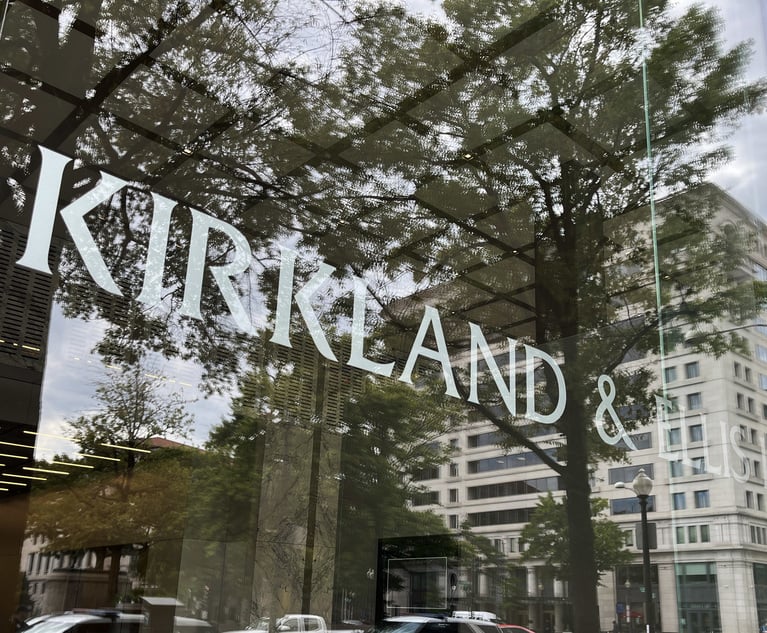Are Law Firms Charging Less or Just Making Less?
In a market where clients are struggling to deliver more legal services for less cost (the challenge), Richard Susskind said a law firm may be tempted to undercut its competition on price in hopes of winning more work.
October 03, 2017 at 01:48 PM
4 minute read

One potential response to what Richard Susskind calls the “more-for-less challenge” facing the legal industry is for law firms to “simply charge less.”
In a market where clients are struggling to deliver more legal services for less cost (the challenge), Susskind said a law firm may be tempted to undercut its competition on price in hopes of winning more work.
But is it actually happening?
While most agree that clients have more leverage today than in decades past, there's little evidence to suggest that law firms have begun to lower their rates or “charge less.” That said, clients have exerted their power in a number of other ways—demanding discounts; implementing budgets and fee guidelines—that have cut into law firms' realization rates. Even if law firms aren't charging less, they are effectively making less.
For starters, law firm rates rose more in 2015 than any year since 2010, according to the latest Real Rate Report by Wolters Kluwer. The 5.4 percent average increase in 2015, however, remains well below the 8 percent growth that was typically seen prior to the recession.
Top-line rates, though, have come to mean less and less as clients have pushed back on paying them in multiple ways. Thomson Reuters Peer Monitor data shows that growth in rates clients agree to pay—what they call worked rates—are growing at a slower pace than that put forth by the Wolters Kluwer data. Worked rates as of mid-2017 had grown 3 percent from the prior year, which is slightly higher than the increases seen in the past three years.
But the hemorrhage doesn't end there. Realization against those worked rates has recently declined. After holding between 89 and 90 percent in previous years, realization in the first quarter dipped below 89 percent for the first time, to 88.6 percent. It rebounded slightly, to 89.1 percent, at the midyear point.
All of which means there is no growth in what clients are paying, according to a newer data set that Thomson Reuters uses to track payments by clients.
“Outside of the Am Law 50, we aren't seeing any appreciable growth in the rates law departments are paying,” said Bill Josten, senior legal industry analyst for the Thomson Reuters Legal Executive Institute.
Josten said the biggest hits to realization don't actually come from clients directly pushing back on bills or requesting write-downs. Instead, Josten said Thomson Reuters data shows that law firms' realization has been hit hardest by actions the law firm takes: Discounting their rates up front and taking write-downs from their bills before they head out the door.
“Some of that is from actual pressure by clients,” Josten said. “Part of it is driven by fear.”
There is one other data point that could convince a managing partner that charging less will not boost your profits.
In a study of what made the country's most profitable firms as successful as they are, Josten said he found that higher realization rates than their less-profitable peers, perhaps unsurprisingly, are a major factor. But the difference in realization is not due to a difference in their clients' behavior.
Josten said the two groups have similar drop-offs in realization after their clients receive the bills. The majority of the difference has to do with law firms discounting their fees or writing down their fees before sending bills to clients. That may suggest that “charging less” is more likely to crimp profit margins than it is to bring in new clients.
“I don't know that it's so simple to say that lawyers are going to just have to charge less or will end up charging less,” Josten said. “It will be more about tailoring rates to practices that will allow you to profit.”
Roy Strom, based in Chicago, covers the business of law with a focus on how law firm business models are changing. He can be reached at [email protected]. On Twitter: @RoyWStrom.
NOT FOR REPRINT
© 2025 ALM Global, LLC, All Rights Reserved. Request academic re-use from www.copyright.com. All other uses, submit a request to [email protected]. For more information visit Asset & Logo Licensing.
You Might Like
View All
Kirkland Is Entering a New Market. Will Its Rates Get a Warm Welcome?
5 minute read

Strategic Pricing: Setting the Billable Hour at the Intersection of Psychology, Feedback and Growth
Trending Stories
- 1Uber Files RICO Suit Against Plaintiff-Side Firms Alleging Fraudulent Injury Claims
- 2The Law Firm Disrupted: Scrutinizing the Elephant More Than the Mouse
- 3Inherent Diminished Value Damages Unavailable to 3rd-Party Claimants, Court Says
- 4Pa. Defense Firm Sued by Client Over Ex-Eagles Player's $43.5M Med Mal Win
- 5Losses Mount at Morris Manning, but Departing Ex-Chair Stays Bullish About His Old Firm's Future
Who Got The Work
J. Brugh Lower of Gibbons has entered an appearance for industrial equipment supplier Devco Corporation in a pending trademark infringement lawsuit. The suit, accusing the defendant of selling knock-off Graco products, was filed Dec. 18 in New Jersey District Court by Rivkin Radler on behalf of Graco Inc. and Graco Minnesota. The case, assigned to U.S. District Judge Zahid N. Quraishi, is 3:24-cv-11294, Graco Inc. et al v. Devco Corporation.
Who Got The Work
Rebecca Maller-Stein and Kent A. Yalowitz of Arnold & Porter Kaye Scholer have entered their appearances for Hanaco Venture Capital and its executives, Lior Prosor and David Frankel, in a pending securities lawsuit. The action, filed on Dec. 24 in New York Southern District Court by Zell, Aron & Co. on behalf of Goldeneye Advisors, accuses the defendants of negligently and fraudulently managing the plaintiff's $1 million investment. The case, assigned to U.S. District Judge Vernon S. Broderick, is 1:24-cv-09918, Goldeneye Advisors, LLC v. Hanaco Venture Capital, Ltd. et al.
Who Got The Work
Attorneys from A&O Shearman has stepped in as defense counsel for Toronto-Dominion Bank and other defendants in a pending securities class action. The suit, filed Dec. 11 in New York Southern District Court by Bleichmar Fonti & Auld, accuses the defendants of concealing the bank's 'pervasive' deficiencies in regards to its compliance with the Bank Secrecy Act and the quality of its anti-money laundering controls. The case, assigned to U.S. District Judge Arun Subramanian, is 1:24-cv-09445, Gonzalez v. The Toronto-Dominion Bank et al.
Who Got The Work
Crown Castle International, a Pennsylvania company providing shared communications infrastructure, has turned to Luke D. Wolf of Gordon Rees Scully Mansukhani to fend off a pending breach-of-contract lawsuit. The court action, filed Nov. 25 in Michigan Eastern District Court by Hooper Hathaway PC on behalf of The Town Residences LLC, accuses Crown Castle of failing to transfer approximately $30,000 in utility payments from T-Mobile in breach of a roof-top lease and assignment agreement. The case, assigned to U.S. District Judge Susan K. Declercq, is 2:24-cv-13131, The Town Residences LLC v. T-Mobile US, Inc. et al.
Who Got The Work
Wilfred P. Coronato and Daniel M. Schwartz of McCarter & English have stepped in as defense counsel to Electrolux Home Products Inc. in a pending product liability lawsuit. The court action, filed Nov. 26 in New York Eastern District Court by Poulos Lopiccolo PC and Nagel Rice LLP on behalf of David Stern, alleges that the defendant's refrigerators’ drawers and shelving repeatedly break and fall apart within months after purchase. The case, assigned to U.S. District Judge Joan M. Azrack, is 2:24-cv-08204, Stern v. Electrolux Home Products, Inc.
Featured Firms
Law Offices of Gary Martin Hays & Associates, P.C.
(470) 294-1674
Law Offices of Mark E. Salomone
(857) 444-6468
Smith & Hassler
(713) 739-1250











